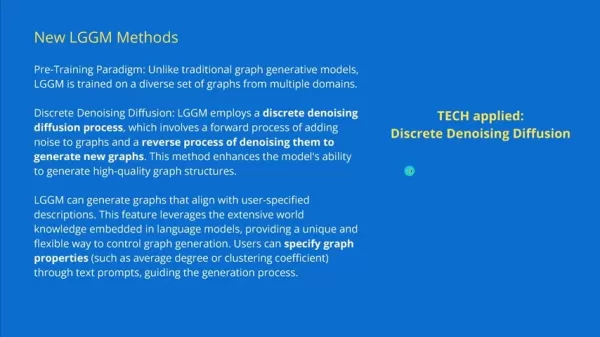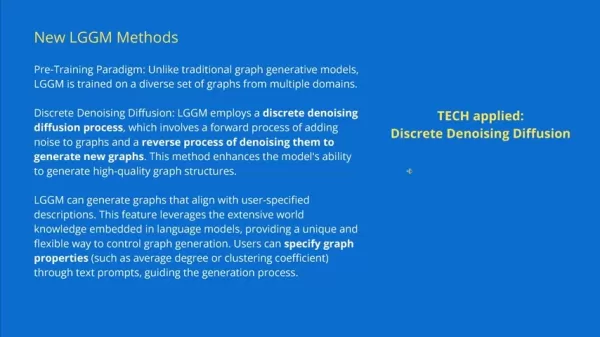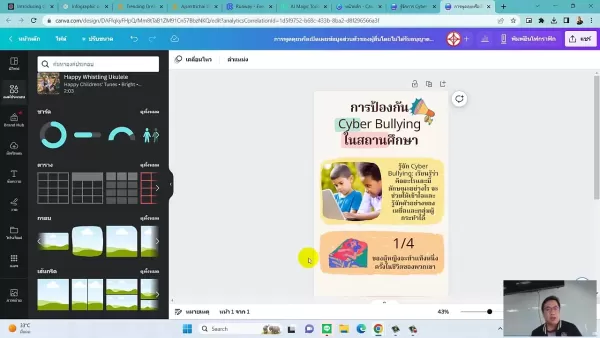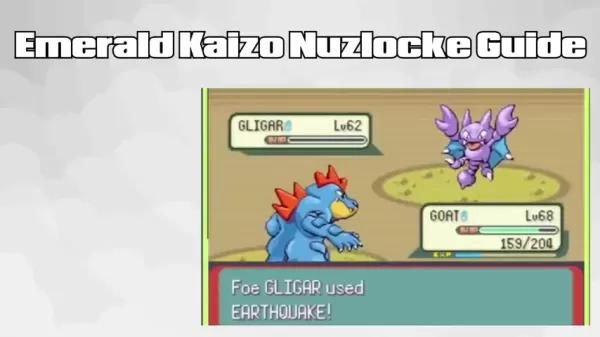LGGM: Transforming AI with Large Generative Graph Models
Artificial intelligence is in a constant state of evolution, with new models and techniques popping up all the time. One of the most intriguing advancements is the emergence of Large Generative Graph Models (LGGMs). These models build on the capabilities of large language models (LLMs) and vision language models (VLMs) by venturing into the world of graph data. This allows for new ways to analyze, generate, and understand data. Let's dive into LGGMs, exploring their structure, methodologies, and how they could revolutionize various industries.
Key Points
- LGGM is a fresh type of generative AI model that merges the strengths of LLMs and VLMs with graph neural networks (GNNs).
- They're pre-trained on vast datasets of graphs spanning different fields, boosting their ability to generalize.
- LGGMs can create graphs from textual prompts, allowing for detailed control over graph generation.
- They have potential applications in drug discovery, material design, social network analysis, and cybersecurity.
- Discrete Denoising Diffusion plays a vital role in LGGM training, helping to produce high-quality graph structures.
Understanding Large Generative Graph Models (LGGMs)
The Evolution of AI Models: From LLMs and VLMs to LGGMs
AI models have come a long way. Large Language Models (LLMs) have been game-changers in natural language processing, mastering tasks like text generation, translation, and answering questions. Then came Vision Language Models (VLMs), which took things up a notch by integrating visual data, allowing them to handle both text and images.
Now, Large Generative Graph Models (LGGMs) are pushing the boundaries even further. They blend the capabilities of LLMs and VLMs with graph neural networks (GNNs), making it possible to work with graph-structured data. This is huge because so many real-world datasets, from social networks to biological networks and knowledge graphs, can be represented as graphs. Being able to generate and analyze these graphs unlocks a whole new world of insights and applications.
Key Benefits of LGGMs:
- Better generalization through pre-training on diverse graph datasets.
- Detailed control over graph generation using textual prompts.
- Applications across various fields, including drug discovery and cybersecurity.
What is the LGGM Model Architecture?
The architecture of an LGGM typically includes several key components:
- Text Encoder: This processes the input textual prompt using techniques from LLMs.
- Graph Neural Network (GNN): It learns representations of existing graphs and generates new graph structures.
- Diffusion Process: This employs a denoising diffusion process to add noise to graphs and then reverse it to generate realistic graph structures. This technology, known as Discrete Denoising Diffusion, is crucial for LGGM's ability to generate high-quality graph structures.

- Text-to-Graph Generation: It integrates knowledge from underlying language models to offer detailed control over graph generation based on textual prompts.
The combination of these components allows the LGGM to translate textual instructions into complex, structured graphs, making it a powerful tool for various tasks.
The Importance of Multi-Domain Pre-Training for LGGMs
Multi-domain pre-training is a critical aspect of LGGM development. Unlike earlier models trained on single-domain datasets, LGGMs are pre-trained on a corpus of over 5000 graphs from 13 distinct domains. This approach helps the LGGM learn more generalizable patterns and relationships, improving its performance across diverse tasks.
This pre-training strategy significantly enhances the model's ability to adapt to new domains and tasks, addressing limitations of previous models. The diverse training data allows the LGGM to capture a wide variety of graph patterns and structures.
Benefits of Multi-Domain Training:
- Improved Generalization.
- Enhanced Adaptability.
- Robust Performance across Diverse Datasets.
Diving Deeper: Techniques Used in LGGM
Discrete Denoising Diffusion: Generating High-Quality Graphs
Discrete Denoising Diffusion is a key technology in LGGM training.

This process involves two main steps:
- Forward Process: Adds noise to existing graphs, gradually degrading their structure.
- Reverse Process: Trains the model to reverse the noise addition, denoising the graphs and generating new, realistic graph structures.
This method enhances the model's ability to generate high-quality graph structures by learning to reconstruct graphs from noisy versions. It's a technique adapted from image generation, where diffusion models have achieved state-of-the-art results.
Specifying Graph Properties Through Textual Prompts
One of the unique features of LGGMs is the ability to specify graph properties through textual prompts. This feature allows users to control various characteristics of the generated graphs, such as:
- Average Degree.
- Clustering Coefficient.
By specifying these properties in the text prompt, users can guide the graph generation process and create graphs that meet their specific requirements. This level of control is not available in traditional GNNs.
Getting Started with Large Generative Graph Models: A Basic Guide
Steps to Implement Large Generative Graph Model
While directly implementing an LGGM from scratch can be complex, here's a simplified overview of the steps involved:
- Data Preparation: Gather a large corpus of graph data from diverse domains.
- Model Architecture: Construct an LGGM architecture combining a text encoder, GNN, and diffusion process.
- Pre-Training: Pre-train the model on the graph corpus using a discrete denoising diffusion process.
- Fine-Tuning: Fine-tune the model on specific target domains to improve performance.
- Text-to-Graph Generation: Implement a text-to-graph generation module that translates textual prompts into graph structures.
Note: This process requires a strong understanding of deep learning, graph neural networks, and diffusion models.
LGGM Pricing
LGGM Pricing
Currently, LGGMs are primarily research models, and direct commercial pricing isn't applicable. However, consider the potential costs associated with:
- Computational Resources: Training and deploying large models require substantial computing power.
- Data Acquisition: Accessing and preparing large graph datasets can incur costs.
- Software and Tools: Utilize appropriate deep learning frameworks and libraries.
As LGGMs mature, specialized services and tools may emerge, offering various pricing models based on usage or subscription.
LGGMs: Pros and Cons
Pros
- Ability to generate new, realistic graph structures.
- Fine-grained control over graph properties through text prompts.
- Potential for applications across diverse domains.
- Multi-domain training leads to better generalization.
Cons
- High computational costs for training and deployment.
- The requirement for large and diverse training datasets.
- Complexity in model architecture and implementation.
- Need for specialized expertise to design and utilize effectively.
Core LGGM Features
Key Functionalities of Large Generative Graph Model
Here are the core functionalities that define the LGGM model:
- Text-to-Graph Generation: LGGMs translate text prompts into structured graphs, enabling user-guided creation of graph data.
- Multi-Domain Learning: By pre-training on diverse datasets, LGGMs generalize and perform well across various applications.
- Customizable Graph Properties: Users can specify graph characteristics (e.g., average degree, clustering coefficient) via text prompts.
- Drug Discovery: Identify potential drug candidates by generating and analyzing molecular graphs with desired properties.
- Data Augmentation: Enhance existing graph datasets by generating synthetic data for improved model training.
Diverse Use Cases for Large Generative Graph Models
Real-World Applications of LGGM Model
LGGMs have potential across a wide range of industries:
- Drug Discovery: Generate molecular graphs with specific properties to identify potential drug candidates. LGGMs hold the ability to generate molecular graphs with desired properties.
- Material Design: Create graphs representing different material structures and predict their properties.
- Social Network Analysis: Generate social network graphs with desired community structures and interaction patterns. Also helps to generate social network graphs with desired properties.
- Cybersecurity: Design network graphs representing different types of network topologies and attack scenarios. With this specific graph generation, generate network graphs to predict potential attack vectors.
Frequently Asked Questions (FAQ) About LGGMs
What is the difference between LGGMs and traditional GNNs?
Traditional GNNs focus on learning embeddings for existing graph nodes, while LGGMs are designed to generate new graphs based on text prompts. It introduces a novel generative approach to enhance large-scale, multi-domain training.
What is discrete denoising diffusion, and why is it important?
Discrete denoising diffusion is a technique that trains the model to reconstruct graphs from noisy versions, enabling the generation of high-quality graph structures.
What kind of characteristics in the text prompt can be customized through LGGM model?
Average Degree and Clustering Coefficient. Also supports domain-specific characteristics to create desired graph models.
Related Questions
How do Large Generative Graph Models relate to other AI models like LLMs and VLMs?
Large Generative Graph Models (LGGMs) represent an evolutionary step in AI development, integrating the strengths of various architectures to handle complex data structures. While LLMs excel in natural language processing and VLMs combine text and image understanding, LGGMs extend these capabilities to graph-structured data. LLMs provide LGGMs with the ability to understand and generate textual descriptions, enabling the use of natural language prompts to guide graph creation. VLMs contribute techniques for processing and integrating visual information, which can be relevant when graph nodes or edges have associated visual data. At its core, LGGMs integrate graph neural networks (GNNs) to model relationships and dependencies within graph data. By leveraging GNNs, LGGMs can capture intricate patterns and generate new graph structures that adhere to specific properties and constraints. The focus is on encoding the graph structure and node features into a lower-dimensional space that captures the essential patterns and relationships within the graph.
Related article
 Best AI Tools for Creating Educational Infographics – Design Tips & Techniques
In today's digitally-driven educational landscape, infographics have emerged as a transformative communication medium that converts complex information into visually appealing, easily understandable formats. AI technology is revolutionizing how educa
Best AI Tools for Creating Educational Infographics – Design Tips & Techniques
In today's digitally-driven educational landscape, infographics have emerged as a transformative communication medium that converts complex information into visually appealing, easily understandable formats. AI technology is revolutionizing how educa
 Topaz DeNoise AI: Best Noise Reduction Tool in 2025 – Full Guide
In the competitive world of digital photography, image clarity remains paramount. Photographers at all skill levels contend with digital noise that compromises otherwise excellent shots. Topaz DeNoise AI emerges as a cutting-edge solution, harnessing
Topaz DeNoise AI: Best Noise Reduction Tool in 2025 – Full Guide
In the competitive world of digital photography, image clarity remains paramount. Photographers at all skill levels contend with digital noise that compromises otherwise excellent shots. Topaz DeNoise AI emerges as a cutting-edge solution, harnessing
 Master Emerald Kaizo Nuzlocke: Ultimate Survival & Strategy Guide
Emerald Kaizo stands as one of the most formidable Pokémon ROM hacks ever conceived. While attempting a Nuzlocke run exponentially increases the challenge, victory remains achievable through meticulous planning and strategic execution. This definitiv
Comments (1)
0/200
Master Emerald Kaizo Nuzlocke: Ultimate Survival & Strategy Guide
Emerald Kaizo stands as one of the most formidable Pokémon ROM hacks ever conceived. While attempting a Nuzlocke run exponentially increases the challenge, victory remains achievable through meticulous planning and strategic execution. This definitiv
Comments (1)
0/200
![WillieLee]() WillieLee
WillieLee
 August 2, 2025 at 11:07:14 AM EDT
August 2, 2025 at 11:07:14 AM EDT
LGGMs sound like a game-changer for AI! I'm curious how they'll stack up against LLMs in real-world tasks. Anyone tried them yet? 🤔


 0
0
Artificial intelligence is in a constant state of evolution, with new models and techniques popping up all the time. One of the most intriguing advancements is the emergence of Large Generative Graph Models (LGGMs). These models build on the capabilities of large language models (LLMs) and vision language models (VLMs) by venturing into the world of graph data. This allows for new ways to analyze, generate, and understand data. Let's dive into LGGMs, exploring their structure, methodologies, and how they could revolutionize various industries.
Key Points
- LGGM is a fresh type of generative AI model that merges the strengths of LLMs and VLMs with graph neural networks (GNNs).
- They're pre-trained on vast datasets of graphs spanning different fields, boosting their ability to generalize.
- LGGMs can create graphs from textual prompts, allowing for detailed control over graph generation.
- They have potential applications in drug discovery, material design, social network analysis, and cybersecurity.
- Discrete Denoising Diffusion plays a vital role in LGGM training, helping to produce high-quality graph structures.
Understanding Large Generative Graph Models (LGGMs)
The Evolution of AI Models: From LLMs and VLMs to LGGMs
AI models have come a long way. Large Language Models (LLMs) have been game-changers in natural language processing, mastering tasks like text generation, translation, and answering questions. Then came Vision Language Models (VLMs), which took things up a notch by integrating visual data, allowing them to handle both text and images.
Now, Large Generative Graph Models (LGGMs) are pushing the boundaries even further. They blend the capabilities of LLMs and VLMs with graph neural networks (GNNs), making it possible to work with graph-structured data. This is huge because so many real-world datasets, from social networks to biological networks and knowledge graphs, can be represented as graphs. Being able to generate and analyze these graphs unlocks a whole new world of insights and applications.
Key Benefits of LGGMs:
- Better generalization through pre-training on diverse graph datasets.
- Detailed control over graph generation using textual prompts.
- Applications across various fields, including drug discovery and cybersecurity.
What is the LGGM Model Architecture?
The architecture of an LGGM typically includes several key components:
- Text Encoder: This processes the input textual prompt using techniques from LLMs.
- Graph Neural Network (GNN): It learns representations of existing graphs and generates new graph structures.
- Diffusion Process: This employs a denoising diffusion process to add noise to graphs and then reverse it to generate realistic graph structures. This technology, known as Discrete Denoising Diffusion, is crucial for LGGM's ability to generate high-quality graph structures.

- Text-to-Graph Generation: It integrates knowledge from underlying language models to offer detailed control over graph generation based on textual prompts.
The combination of these components allows the LGGM to translate textual instructions into complex, structured graphs, making it a powerful tool for various tasks.
The Importance of Multi-Domain Pre-Training for LGGMs
Multi-domain pre-training is a critical aspect of LGGM development. Unlike earlier models trained on single-domain datasets, LGGMs are pre-trained on a corpus of over 5000 graphs from 13 distinct domains. This approach helps the LGGM learn more generalizable patterns and relationships, improving its performance across diverse tasks.
This pre-training strategy significantly enhances the model's ability to adapt to new domains and tasks, addressing limitations of previous models. The diverse training data allows the LGGM to capture a wide variety of graph patterns and structures.
Benefits of Multi-Domain Training:
- Improved Generalization.
- Enhanced Adaptability.
- Robust Performance across Diverse Datasets.
Diving Deeper: Techniques Used in LGGM
Discrete Denoising Diffusion: Generating High-Quality Graphs
Discrete Denoising Diffusion is a key technology in LGGM training.
This process involves two main steps:
- Forward Process: Adds noise to existing graphs, gradually degrading their structure.
- Reverse Process: Trains the model to reverse the noise addition, denoising the graphs and generating new, realistic graph structures.
This method enhances the model's ability to generate high-quality graph structures by learning to reconstruct graphs from noisy versions. It's a technique adapted from image generation, where diffusion models have achieved state-of-the-art results.
Specifying Graph Properties Through Textual Prompts
One of the unique features of LGGMs is the ability to specify graph properties through textual prompts. This feature allows users to control various characteristics of the generated graphs, such as:
- Average Degree.
- Clustering Coefficient.
By specifying these properties in the text prompt, users can guide the graph generation process and create graphs that meet their specific requirements. This level of control is not available in traditional GNNs.
Getting Started with Large Generative Graph Models: A Basic Guide
Steps to Implement Large Generative Graph Model
While directly implementing an LGGM from scratch can be complex, here's a simplified overview of the steps involved:
- Data Preparation: Gather a large corpus of graph data from diverse domains.
- Model Architecture: Construct an LGGM architecture combining a text encoder, GNN, and diffusion process.
- Pre-Training: Pre-train the model on the graph corpus using a discrete denoising diffusion process.
- Fine-Tuning: Fine-tune the model on specific target domains to improve performance.
- Text-to-Graph Generation: Implement a text-to-graph generation module that translates textual prompts into graph structures.
Note: This process requires a strong understanding of deep learning, graph neural networks, and diffusion models.
LGGM Pricing
LGGM Pricing
Currently, LGGMs are primarily research models, and direct commercial pricing isn't applicable. However, consider the potential costs associated with:
- Computational Resources: Training and deploying large models require substantial computing power.
- Data Acquisition: Accessing and preparing large graph datasets can incur costs.
- Software and Tools: Utilize appropriate deep learning frameworks and libraries.
As LGGMs mature, specialized services and tools may emerge, offering various pricing models based on usage or subscription.
LGGMs: Pros and Cons
Pros
- Ability to generate new, realistic graph structures.
- Fine-grained control over graph properties through text prompts.
- Potential for applications across diverse domains.
- Multi-domain training leads to better generalization.
Cons
- High computational costs for training and deployment.
- The requirement for large and diverse training datasets.
- Complexity in model architecture and implementation.
- Need for specialized expertise to design and utilize effectively.
Core LGGM Features
Key Functionalities of Large Generative Graph Model
Here are the core functionalities that define the LGGM model:
- Text-to-Graph Generation: LGGMs translate text prompts into structured graphs, enabling user-guided creation of graph data.
- Multi-Domain Learning: By pre-training on diverse datasets, LGGMs generalize and perform well across various applications.
- Customizable Graph Properties: Users can specify graph characteristics (e.g., average degree, clustering coefficient) via text prompts.
- Drug Discovery: Identify potential drug candidates by generating and analyzing molecular graphs with desired properties.
- Data Augmentation: Enhance existing graph datasets by generating synthetic data for improved model training.
Diverse Use Cases for Large Generative Graph Models
Real-World Applications of LGGM Model
LGGMs have potential across a wide range of industries:
- Drug Discovery: Generate molecular graphs with specific properties to identify potential drug candidates. LGGMs hold the ability to generate molecular graphs with desired properties.
- Material Design: Create graphs representing different material structures and predict their properties.
- Social Network Analysis: Generate social network graphs with desired community structures and interaction patterns. Also helps to generate social network graphs with desired properties.
- Cybersecurity: Design network graphs representing different types of network topologies and attack scenarios. With this specific graph generation, generate network graphs to predict potential attack vectors.
Frequently Asked Questions (FAQ) About LGGMs
What is the difference between LGGMs and traditional GNNs?
Traditional GNNs focus on learning embeddings for existing graph nodes, while LGGMs are designed to generate new graphs based on text prompts. It introduces a novel generative approach to enhance large-scale, multi-domain training.
What is discrete denoising diffusion, and why is it important?
Discrete denoising diffusion is a technique that trains the model to reconstruct graphs from noisy versions, enabling the generation of high-quality graph structures.
What kind of characteristics in the text prompt can be customized through LGGM model?
Average Degree and Clustering Coefficient. Also supports domain-specific characteristics to create desired graph models.
Related Questions
How do Large Generative Graph Models relate to other AI models like LLMs and VLMs?
Large Generative Graph Models (LGGMs) represent an evolutionary step in AI development, integrating the strengths of various architectures to handle complex data structures. While LLMs excel in natural language processing and VLMs combine text and image understanding, LGGMs extend these capabilities to graph-structured data. LLMs provide LGGMs with the ability to understand and generate textual descriptions, enabling the use of natural language prompts to guide graph creation. VLMs contribute techniques for processing and integrating visual information, which can be relevant when graph nodes or edges have associated visual data. At its core, LGGMs integrate graph neural networks (GNNs) to model relationships and dependencies within graph data. By leveraging GNNs, LGGMs can capture intricate patterns and generate new graph structures that adhere to specific properties and constraints. The focus is on encoding the graph structure and node features into a lower-dimensional space that captures the essential patterns and relationships within the graph.
 Best AI Tools for Creating Educational Infographics – Design Tips & Techniques
In today's digitally-driven educational landscape, infographics have emerged as a transformative communication medium that converts complex information into visually appealing, easily understandable formats. AI technology is revolutionizing how educa
Best AI Tools for Creating Educational Infographics – Design Tips & Techniques
In today's digitally-driven educational landscape, infographics have emerged as a transformative communication medium that converts complex information into visually appealing, easily understandable formats. AI technology is revolutionizing how educa
 Topaz DeNoise AI: Best Noise Reduction Tool in 2025 – Full Guide
In the competitive world of digital photography, image clarity remains paramount. Photographers at all skill levels contend with digital noise that compromises otherwise excellent shots. Topaz DeNoise AI emerges as a cutting-edge solution, harnessing
Topaz DeNoise AI: Best Noise Reduction Tool in 2025 – Full Guide
In the competitive world of digital photography, image clarity remains paramount. Photographers at all skill levels contend with digital noise that compromises otherwise excellent shots. Topaz DeNoise AI emerges as a cutting-edge solution, harnessing
 Master Emerald Kaizo Nuzlocke: Ultimate Survival & Strategy Guide
Emerald Kaizo stands as one of the most formidable Pokémon ROM hacks ever conceived. While attempting a Nuzlocke run exponentially increases the challenge, victory remains achievable through meticulous planning and strategic execution. This definitiv
Master Emerald Kaizo Nuzlocke: Ultimate Survival & Strategy Guide
Emerald Kaizo stands as one of the most formidable Pokémon ROM hacks ever conceived. While attempting a Nuzlocke run exponentially increases the challenge, victory remains achievable through meticulous planning and strategic execution. This definitiv
 August 2, 2025 at 11:07:14 AM EDT
August 2, 2025 at 11:07:14 AM EDT
LGGMs sound like a game-changer for AI! I'm curious how they'll stack up against LLMs in real-world tasks. Anyone tried them yet? 🤔


 0
0





























